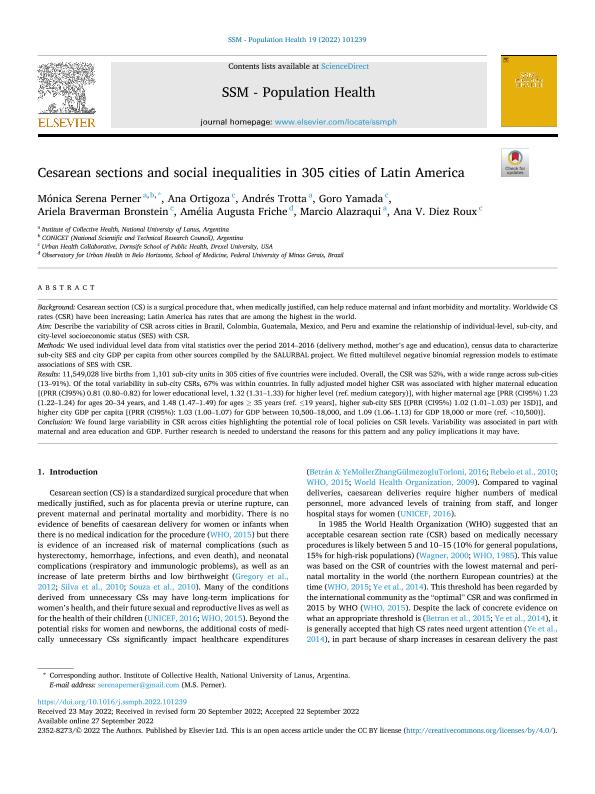Artículo
Cesarean sections and social inequalities in 305 cities of Latin America
Perner, Mónica Serena ; Ortigoza, Ana; Trotta, Andrés; Yamada, Goro; Braverman Bronstein, Ariela; Friche, Amélia Augusta; Alazraqui, Marcio; Diez Roux, Ana Victoria
; Ortigoza, Ana; Trotta, Andrés; Yamada, Goro; Braverman Bronstein, Ariela; Friche, Amélia Augusta; Alazraqui, Marcio; Diez Roux, Ana Victoria
 ; Ortigoza, Ana; Trotta, Andrés; Yamada, Goro; Braverman Bronstein, Ariela; Friche, Amélia Augusta; Alazraqui, Marcio; Diez Roux, Ana Victoria
; Ortigoza, Ana; Trotta, Andrés; Yamada, Goro; Braverman Bronstein, Ariela; Friche, Amélia Augusta; Alazraqui, Marcio; Diez Roux, Ana Victoria
Fecha de publicación:
09/2022
Editorial:
Elsevier
Revista:
SSM - Population Health
ISSN:
2352-8273
Idioma:
Inglés
Tipo de recurso:
Artículo publicado
Clasificación temática:
Resumen
Background: Cesarean section (CS) is a surgical procedure that, when medically justified, can help reduce maternal and infant morbidity and mortality. Worldwide CS rates (CSR) have been increasing; Latin America has rates that are among the highest in the world. Aim: Describe the variability of CSR across cities in Brazil, Colombia, Guatemala, Mexico, and Peru and examine the relationship of individual-level, sub-city, and city-level socioeconomic status (SES) with CSR. Methods: We used individual level data from vital statistics over the period 2014–2016 (delivery method, mother's age and education), census data to characterize sub-city SES and city GDP per capita from other sources compiled by the SALURBAL project. We fitted multilevel negative binomial regression models to estimate associations of SES with CSR. Results: 11,549,028 live births from 1,101 sub-city units in 305 cities of five countries were included. Overall, the CSR was 52%, with a wide range across sub-cities (13–91%). Of the total variability in sub-city CSRs, 67% was within countries. In fully adjusted model higher CSR was associated with higher maternal education [(PRR (CI95%) 0.81 (0.80–0.82) for lower educational level, 1.32 (1.31–1.33) for higher level (ref. medium category)], with higher maternal age [PRR (CI95%) 1.23 (1.22–1.24) for ages 20–34 years, and 1.48 (1.47–1.49) for ages ≥ 35 years (ref. ≤19 years], higher sub-city SES [(PRR (CI95%) 1.02 (1.01–1.03) per 1SD)], and higher city GDP per capita [(PRR (CI95%): 1.03 (1.00–1.07) for GDP between 10,500–18,000, and 1.09 (1.06–1.13) for GDP 18,000 or more (ref. <10,500)]. Conclusion: We found large variability in CSR across cities highlighting the potential role of local policies on CSR levels. Variability was associated in part with maternal and area education and GDP. Further research is needed to understand the reasons for this pattern and any policy implications it may have.
Palabras clave:
CESAREAN SECTION
,
SOCIAL INEQUALITIES
,
MEDICALIZATION
,
MULTILEVEL ANALYSIS
Archivos asociados
Licencia
Identificadores
Colecciones
Articulos(SEDE CENTRAL)
Articulos de SEDE CENTRAL
Articulos de SEDE CENTRAL
Citación
Perner, Mónica Serena; Ortigoza, Ana; Trotta, Andrés; Yamada, Goro; Braverman Bronstein, Ariela; et al.; Cesarean sections and social inequalities in 305 cities of Latin America; Elsevier; SSM - Population Health; 19; 9-2022; 1-8
Compartir
Altmétricas



